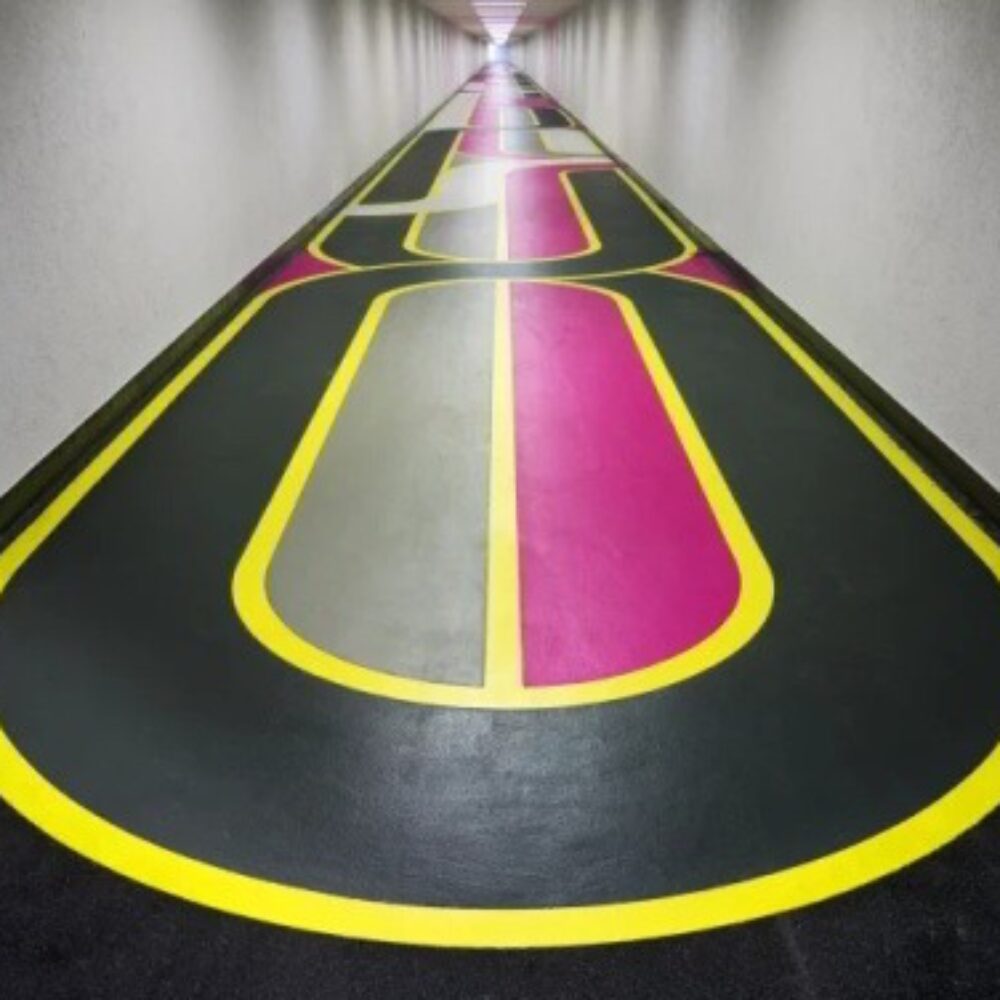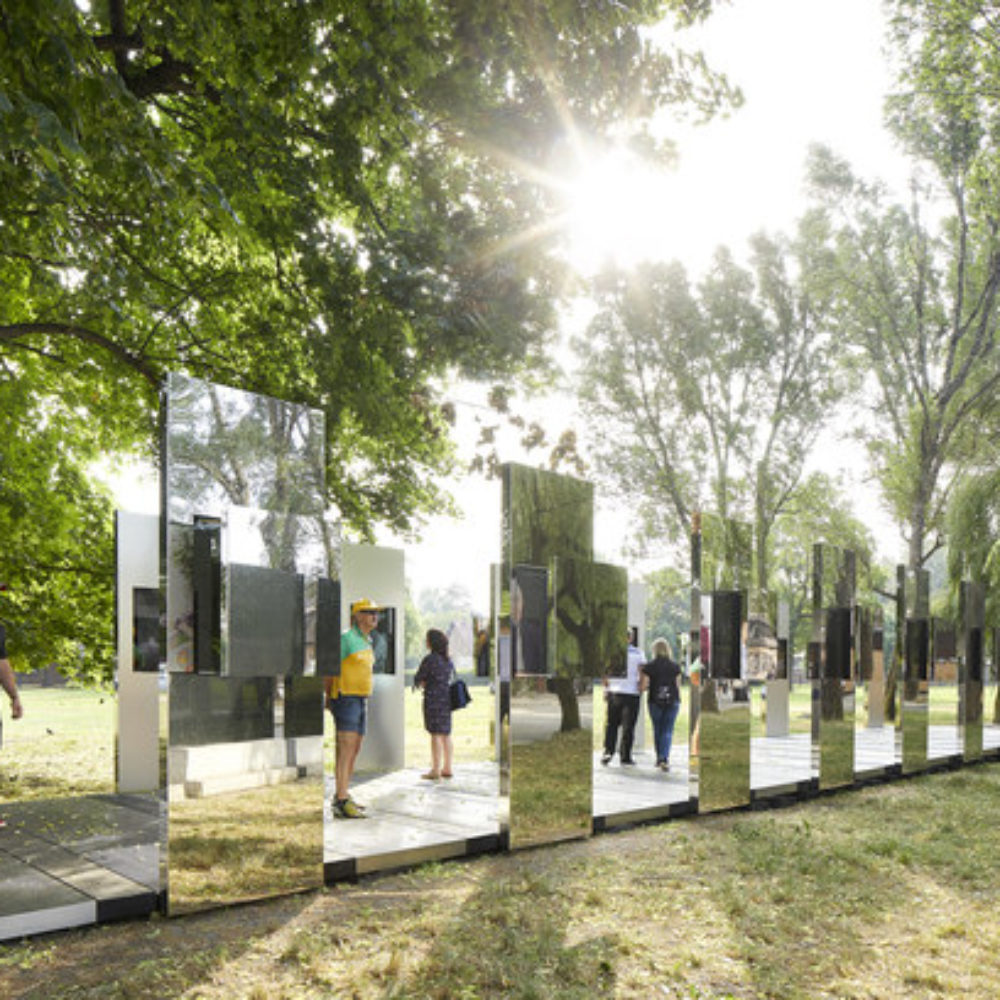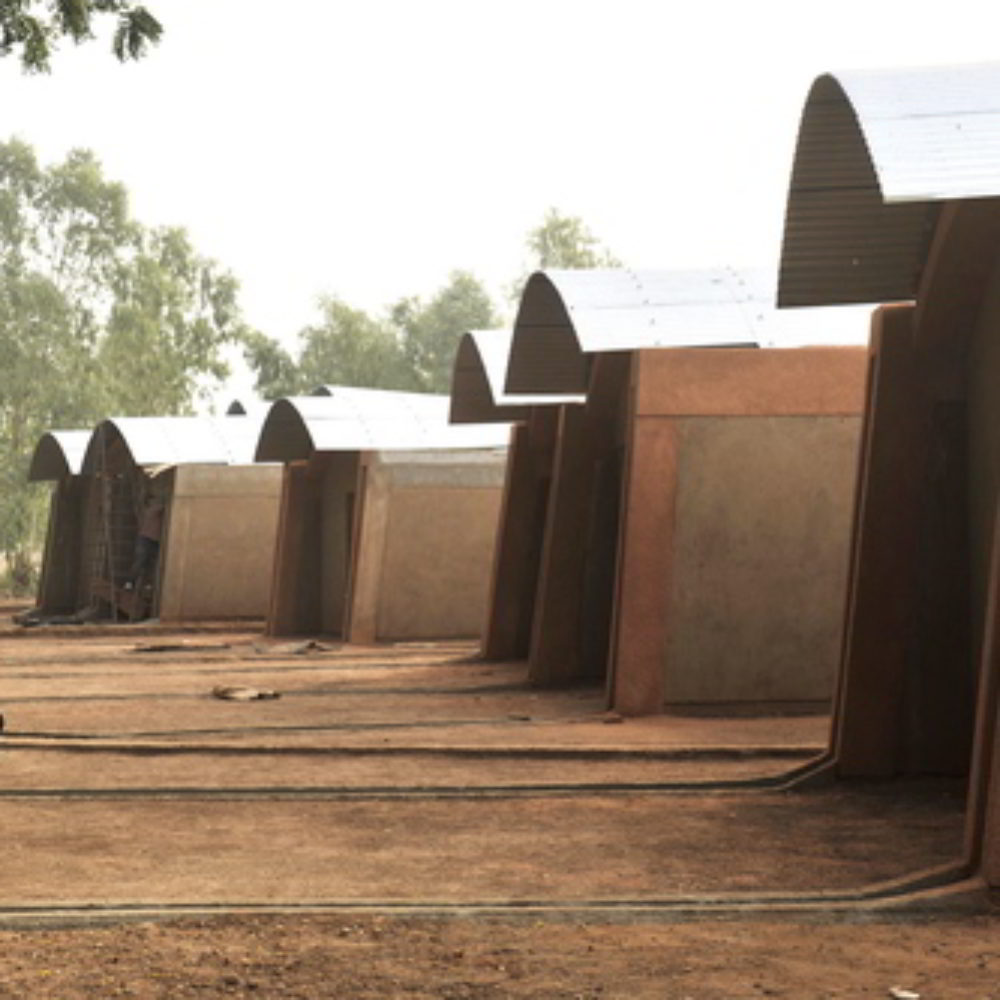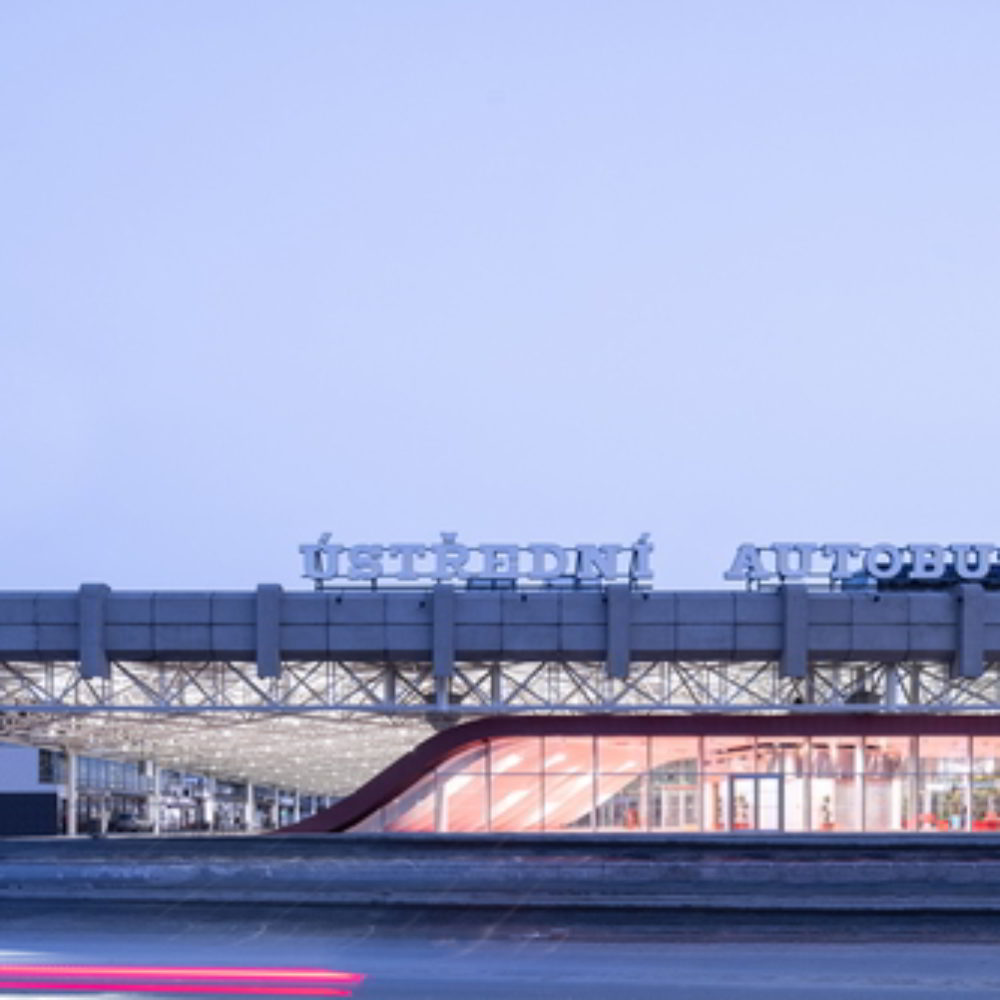Ist das Panorama der Dinosaurier der Massenunterhaltung? Yadegar Asisi sagt ganz klar: nein – und beantwortet Fragen zu anderen Panoramen und Panoramamachern der Kunstgeschichte, diversen Themen wie Virtual Reality und den Folgen, die die Ausstellung „9/11“ für seine Arbeit haben wird.
15. März 2023 | Özlem Özdemir
Özlem Özdemir: Sie sagen, das Panorama ist eine körperliche Erfahrung. So ist New York 9/11 – Krieg in Zeiten von Frieden sehr visuell und akustisch. Zugleich wenden Sie sich aber an den Intellekt, denn es kommen Gastautoren ins Spiel, darunter die Schriftstellerin Shida Bazyar, der ehemalige Professor für Ästhetik Bazon Brock, die Theologin Margot Käßmann, der Politik- und Islamwissenschaftler Michael Lüders und Regisseur Wim Wenders. Hatten Sie zu all den Autoren Kontakt und wie sind die Texte in der Ausstellung integriert?
Yadegar Asisi: Ja, es gibt zu allen Autoren einen direkten Kontakt. Manche kenne ich schon lange und andere, die ich gerne dabeihaben wollte, habe ich angerufen, angeschrieben oder getroffen. Alle Texte wurden extra für die Ausstellung geschrieben. Ich wollte bei 9/11 gerne die Sichtweise von anderen Personen zulassen, weil ich es für ein sehr komplexes Thema halte. Alle Autoren haben sich ein Thema herausgesucht, das sie berührt: Wim Wenders zum Beispiel, den ich seit den 80er-Jahren kenne. Ich sagte zu ihm‚ deine Arbeit und Weltsicht, das hätte ich gerne dabei, es wäre toll, wenn du etwas für die Ausstellung machst! Er sagte, er habe damals, kurz nach dem Anschlag, ein Bild fotografiert – und so beschreibt er im Text, was er erlebte: diesen Staub, als Tote gefunden wurden, die Glocken läuteten und es eine Schweigeminute gab, wie plötzlich die Sonne so stand, dass sie sich in einem Wolkenkratzer spiegelte und das Licht direkt in das Loch fiel. Das Bild, ich glaube, es ist 5 Meter hoch, hängt in der Ausstellung und man sieht diesen Lichtstrahl, der in das Loch fällt. Und dazu kommen seine brillanten Worte. Wir haben versucht, die Texte denjenigen Installationen beizufügen, die thematisch am besten passen.
ÖÖ: Ich war auch neugierig geworden auf den historischen Hintergrund des Panoramas und stieß auf Robert Barker …
YA: Natürlich, Robert Barker ist der Erfinder des Panoramas. Er war ein in Schottland lebender irischer Maler. Er ist in Edinburgh spazieren gegangen und hatte plötzlich eine Idee. Er stellte Leinwände im Kreis auf, stellte sich in ihre Mitte, drehte sich im Kreis und malte immer das, was dahinter zu sehen war auf die Leinwände. So entstand die Idee des Panoramas. Barker meldete sie direkt zum Patent an und wurde zum ersten großen Panorama-Macher des 19. Jahrhunderts.
Die Kunstgeschichtler unserer Zeit bezeichnen das Panorama als den Dinosaurier der Massenunterhaltung des 19. Jahrhunderts: Was für ein Begriff! Ich hatte 1993 die Ausstellung in der Bonner Kunsthalle Sehsucht [sic]: Das Panorama als Massenunterhaltung des 19. Jahrhunderts mitgemacht, die von Marie-Luise von Plessen konzipiert wurde. Damals sagte ich, es kann nicht sein, dass das ein Dinosaurier ist, und wir sollten darüber nachdenken, was ein solches Panorama eigentlich kann. In der zweiten Hälfte des 19. Jahrhunderts ist es in Misskredit geraten, weil es zu viel kostete und dadurch die Aufträge nur durch Institutionen und Regierungen zustande kamen. Im Ergebnis waren sie ideologisch besetzt. Wenn ich etwas geschafft habe, dann das: Ich habe das Panorama von diesem Nimbus befreit. Sie können sich nicht vorstellen, wie viele Auftragsangebote ich in den letzten 20 Jahren abgelehnt habe. Ich bin eben kein Dienstleister. Aber aktuell gibt es wieder intensive Gespräche zu neuen, künstlerisch interessanten Projekten u. a. für Südamerika und die Türkei, die mich wirklich interessieren.
ÖÖ: Kommen wir nochmals zu den historischen Panoramen. Sehr spannend finde ich Mesdag (1881) von Hendrik Willem Mesdag. Ein zylinderförmiges Gemälde der Nordsee bei Scheveningen an der Haager Küste. Darin ist ein nachgebauter Strand integriert, mitten im Rundbau, wobei der Übergang zum Gemälde kaum sichtbar ist und damit eine Illusion der Wirklichkeit entsteht. Als ich Bilder davon sah, fand ich das erstaunlich modern. Illusion ist ein Bereich mehr, mit dem Sie sich beschäftigt haben …
YA: Wenn Sie über Mesdag sprechen, dann können Sie sich auch das Bourbaki-Panorama in Luzern anschauen. Beide folgen dem Prinzip des Faux Terrain, das Gebiet vor dem Bild. In Schlachten liegen dann da z. B. Puppen als tote Soldaten verkleidet, was alles andere als modern ist. Mesdag und Bourbaki sind hierbei aber eine seltene Ausnahme. Ich versuche es mit einem Beispiel zu erklären. Sie stellen ein Wohnzimmer mit einer Fototapete dar, haben aber einen realen dreidimensionalen Stuhl davor. Wenn Sie sich jetzt bewegen, dann bewegt sich auch der Stuhl vor der Fototapete. Auf der Fototapete selbst ist auch ein Stuhl, der bewegt sich in seinem Hintergrund natürlich nicht. Es entsteht eine Diskrepanz zum dreidimensionalen Objekt, weil Sie es bezogen zum illusionistisch Gemalten anders sehen. Mesdag und Bourbaki funktionieren mithilfe „neutraler“ Objekte wie Sand oder Schnee. Wenn aber beispielsweise der Sand eine Kuhle hätte, würde der Effekt verloren gehen.
ÖÖ: Gibt es Künstler und Künstlerinnen oder Stilrichtungen, die Sie inspirieren?
YA: Oh ja. Es gibt zum Beispiel einen russischen Maler, den ich sehr liebe und für seine Komplexität von Gruppenbildern bewundere, Ilja Repin. Ich sehe ihn als einen gegenständlichen Maler, der zu Zeiten von Liebermann oder Menzel fantastische Bilder gemacht hat, unglaublich realistisch, verdichtet und mit einem psychologischem Tiefgang ohne dabei choreografiert auszusehen.
Das war für mich eine Inspiration. So wirken die Szenerien, die ich aufbaue, sehr natürlich. Die Leute wissen immer nicht, wie das passiert. Allein mit Fotografie ist das nicht getan. Sie müssen im Computer die Menschen ummodeln und farbig anders anlegen. Manchmal wechsle ich Köpfe, Blicke oder Hände aus, damit eine Interaktion zwischen den Menschen entsteht.
Bei den zeitgenössischen Künstlern finde ich David Hockney super. Als ich studierte, dachte ich erst, was macht der für Unsinn. Aber ich finde ihn ganz, ganz toll. Oder Edvard Munch … ich könnte da so viele aufzählen.
Wesentlich ist für mich die Trennung zwischen dem Kunstmarkt und dem, was mich wirklich begeistert. Wo immer ich in der Welt hinkomme, sehe ich Künstler und Künstlerinnen, von denen niemand was kennt. Man ist absolut fasziniert, was für fabelhafte Sachen existieren. Leider gibt es für diese oft keine Bühne. Ich habe viel Hochachtung vor den namenlosen Kunstschaffenden dieser Welt.

ÖÖ: Würden Sie sich als Panorama-Künstler bezeichnen?
YA: Ich gebe mir keinen Titel. Ich bin Regisseur, Fotograf, Maler und Zeichner. Ich trenne das nicht. Ich bin auch Architekt. Ohne mein architektonisches Wissen könnte ich diese Bilder nicht machen. Was ich mache, ist wirklich sehr vielfältig, aber eine konkrete Bezeichnung ist mir nicht wichtig. Wichtig ist nur, dass ich einen Raum für mich erobert habe, in dem es wunderbar ist, zu agieren. Haben Sie eigentlich meinen Youtube-Kanal schon mal gesehen?
ÖÖ: Ja, da habe ich selbstverständlich reingeschaut.
YA: Dann wissen Sie, was ich dort mache. Ich bringe den Leuten nicht das Zeichnen wegen des Zeichnens bei, sondern ich frage mich, was wir in unserer Bildungspolitik machen, wenn wir noch nicht mal den Kindern das Zeichnen erhalten. Was wir brauchen, ist Persönlichkeitsentwicklung, Reflexionsfähigkeit, soziale Kompetenz und Empathie. Das Wissen ist da. Wir müssen aber den Menschen beibringen, wie man mit dem Wissen dieser Welt umgeht.
ÖÖ: Das erinnert an die Romantik, eine Epoche der Empfindungen und Gefühle, als die Gesellschaft gerade diese Fähigkeiten, die Sie andeuten, pflegten …
YA: Ja, da war z. B. Goethe – und der konnte zeichnen. Er hat ein Handwerk gelernt und mit diesem viel gemacht. Ich sage immer, Zeichnen ist so wichtig wie Lesen und Schreiben. Da schauen die Leute mich an und sagen Lesen und Schreiben ist doch wichtiger. Da sage ich Nein, ich wäre nicht das, was ich bin, wenn ich nicht gezeichnet hätte. Zeichnen ist eine andere Form von Weltvereinnahmung. Viele Menschen begreifen das aber nicht und denken, das Rationale ist entscheidend. Aber unsere emotionale Seite, unsere Sinne, sind ebenso wichtig, also Tasten und Riechen. Allein das Riechen ist ein komplexes Kulturinstrument, wenn man es so will. Aber zurück zu YouTube. Wenn man dort reinschaut, dann sieht man auch, welche Art von Herangehensweise ich habe.
ÖÖ: Ihr Youtube-Kanal ist außerdem ein weiteres Beispiel für Ihre extreme Produktivität – in alle Richtungen.
YA: Für mich gehört das alles zusammen. Mich einzuordnen ist daher schwierig. Ich werde höchstwahrscheinlich in drei, vier Jahren eine große Retrospektive in Leipzig machen: sozusagen einen Gesamtwerkversuch, ein Versuch, all die Facetten zu zeigen, die notwendig waren, um das zu machen, was ich mache. Ich habe allein angefangen, fühle mich mit meinem Team aber mittlerweile eher wie in einer Malwerkstatt der Renaissance.
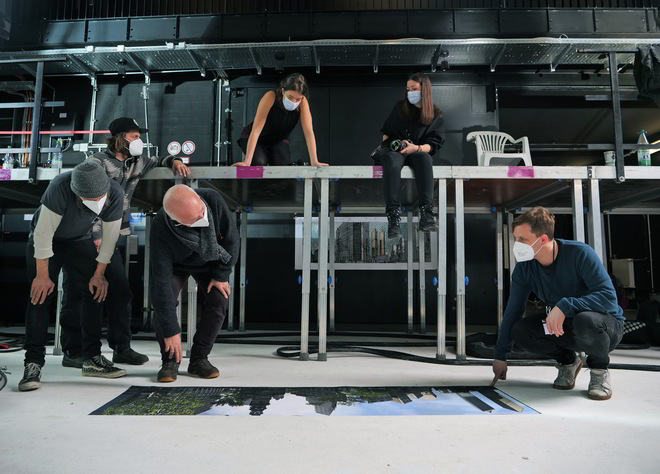

ÖÖ: Sie würden aber nicht so weit gehen zu sagen, dass es keine Panorama-Kunstszene gibt?
YA: Ich bin seit langer Zeit im International Panorama Council (IPC). Seit 30, 40 Jahren ist diese Organisation dabei, die Geschichte aufzuarbeiten und bietet einen internationalen Überblick darüber, wer panoramatisch arbeitet. Die ganze Virtual-Reality-Geschichte ist ja im Prinzip ein panoramatischer Blick. So gesehen war Leonardo da Vinci für mich der Erste, der darüber nachdachte. Er wusste selbst nichts über die Komplexität. Das hat Robert Barker dann mit der Erfindung des Panoramas gemacht.
Kugelprojektionen und all diese Sachen gehören auch dazu. Es war immer der Wunsch der Menschen, in eine 1-zu-1 Realität eintauchen zu können, und mit den virtuellen Welten beginnen wir jetzt damit. Deswegen glaube ich, dass meine Panoramen zwischen Vergangenheit und Zukunft vermitteln.
Letztendlich ist alles Virtuelle panoramatisch. Chinesen und Nordkoreaner etwa machen noch immer ihre klassischen Panoramen. Dort ist das noch sehr ideologisch besetzt. Die Künstler sind Dienstleister für ihre Auftraggeber. Deswegen sagte ich, dass ich das Panorama vielleicht wieder zu einem wirklichen Kunstwerk gemacht habe. Und ich glaube nicht, dass irgendjemand auf der Welt es genauso macht, wie ich es mache.
ÖÖ: Apropos Virtual Reality: Das ist weitverbreitet, Stichwort 3D-Scan-Methoden – die im Bereich Archäologie und Denkmalpflege für virtuelle Rekonstruktionen angewendet werden – oder IMAX DOME Kino oder VR-Entspannungsbrillen für Senioren. Interessanterweise, passt Ihre Richtung gut rein in diese technologische Welle von Virtual Reality & Co.
YA: Ich habe ja angefangen als Virtual Reality etc. so noch gar nicht existierten. Die ersten Kugelprojektionen habe ich in den 80er-Jahren gemacht und die ersten Panoramen 1993. Da war die Technik noch gar nicht da. Ich habe Sachen entwickelt und kurz danach kam die erste Software von Apple: also was Sie jetzt mit jedem iPhone machen können – Sie drehen sich und dann erstellt das Telefon ein Panorama.
Ich habe eines der ersten elektronischen Panoramen in der Hochschule gebaut. Das war Anfang der 2000er-Jahre. Ich sagte damals, dass das der billigste Raumsimulator ist, den es auf dieser Welt gibt. Da waren die Amerikaner schon zugange mit Cave [Cave Automatic Virtual Environment – eine Form von VR, mit der sich Daten räumlich visualisieren lassen, entwickelt von University of Illinois at Chicago; Anm. d. V.] und eine solche Installation hat 2 Millionen gekostet! [Diese „CAVE-Installation“ ist ein Würfel, welcher von 1 bis 6 Seiten mit 2-12 Beamern oder 3D LED Wänden bespielt wird, wodurch ein dreidimensionaler virtueller Raum im Inneren des Würfels entsteht; Anm. d. V.] Also was das betrifft, hatte ich vielleicht Glück, dass ich dieser Bewegung einen halben Schritt voraus war.
ÖÖ: Sie waren also vielen voraus und haben viel Erfolg mit Ihren Panoramen. Manche zeigen Sie sogar im Ausland. Es würde den Rahmen sprengen, auf all Ihre Aktivitäten einzugehen, denn Ihre Schaffenspalette ist so immens wie Ihre Arbeiten. Eine letzte Frage zu Ihrem aktuellen Panorama in Leipzig. 9/11 war global gesehen ein folgenreiches Ereignis. Welche Folgen wird die Ausstellung 9/11 für Sie und Ihr Werk haben?
YA: Ich bleibe bei meinem Narrativ des Werdens und Vergehens dieser Welt. Meine neue Themen, die nun in der Konzeptphase stehen, beschäftigen sich insbesondere mit dem multikulturellen Zusammenleben der Menschen. Die Fragen, die ich mir dabei stelle, sind: Was bedeutet eigentlich Religionsgemeinschaft? Warum können verschiedene Religionen nicht zusammenleben? Ich beschreibe etwas, wozu wir bereits in der Lage sind, denn wir haben es geschichtlich bewiesen. Warum schaffen wir es heute nicht mehr? Wenn ich Fragen provoziere, habe ich vielleicht einen kleinen Beitrag geleistet. 9/11 steht nicht für etwas Neues, sondern ist ganz im Kontinuum meines Gesamtwerks. Und ich rede auch gar nicht mehr von Einzelprojekten, sondern von einem Gesamtwerk. Denn ich merke immer mehr, dass die Panoramen, die ich bisher gemacht habe, einen roten Faden haben. Ich hoffe, dass die Menschen das dann in der Retrospektive sehen werden und sie in einem Zusammenhang verstehen.
ÖÖ: Also eine Retrospektive ist in absehbarer Zukunft geplant?
YA: Ja, 2025 werde ich 70. Das bedeutet nicht unbedingt, dass ich das in dem Jahr mache, aber ich meine, das ist ein gutes Alter, um mal nachzudenken, was man eigentlich so vollbracht hat. ♦
Yadegar Asisi on his panorama „9/11“ and how he thinks about the world
Is the panorama the dinosaur of mass entertainment? Yadegar Asisi firmly declares: no – and answers questions about other panoramas and panorama makers in art history, diverse topics like virtual reality and the consequences the „9/11“ exhibition will have for his work.
Özlem Özdemir: You say the panorama is a bodily experience. So New York 9/11 – War in Times of Peace is very visual and aural. At the same time, however, you address the intellect, as guest authors come into play, including the writer Shida Bazyar, the former professor of aesthetics Bazon Brock, the theologian Margot Käßmann, the political scientist and Islamic scholar Michael Lüders and director Wim Wenders. Did you have contact with all the authors, and how are the texts integrated into the exhibition?
Yadegar Asisi: Yes, we have direct contact with all the authors. Some of them I have known for a long time, and others I wanted to have with me, I called, wrote to or met. All the texts have been written exclusively for the exhibition. I wanted to allow other perspectives on 9/11 because, I think, it is a complex subject. All the authors chose a topic that touched them: let’s take Wim Wenders, whom I have known since the 1980s. I said, I would love to have your work and world view; it would be great if you did something for the exhibition! He said he had taken a picture at that time, shortly after the attack – and this is how he describes in the text what he experienced: this dust, when dead bodies were found, the bells rang, and there was a minute’s silence, how suddenly the sun was in such a position that it was reflected in a skyscraper and the light fell directly into the hole. The picture, I guess it’s 5 metres high, hangs in the exhibition, and you can see this beam of light falling into the hole. And on top of that are his brilliant words. We tried to attach the texts to the installations that fit best thematically.
ÖÖ: I was also curious about the historical background of the panorama and came across Robert Barker …
YA: Of course, Robert Barker is the inventor of the panorama. He was an Irish painter living in Scotland. Walking in Edinburgh, he suddenly had an idea. He set up canvases in a circle, placed himself in their middle, turned himself around and kept painting on the canvases whatever he could see behind them. That is how the idea of the panorama was born. Barker directly applied for a patent and became the first great panorama maker of the 19th century.
The art historians of our time refer to the panorama as the dinosaur of 19th-century mass entertainment: what a term! In 1993, I was part of the exhibition at the Bonn Kunsthalle Sehsucht: Das Panorama als Massenunterhaltung des 19. Jahrhunderts (Addicted to Seeing: The Panorama as Mass Entertainment of the 19th Century; trans. by the editor), conceived by Marie-Luise von Plessen. What I said then: It can’t be that this is a dinosaur, and we should think about what the panorama can actually do. In the second half of the 19th century, it fell into disrepute because it cost too much, therefor the commissions only came about through institutions and governments. Ultimately, they were full of ideology. If there’s one thing I’ve managed to do, it’s this: I’ve freed the panorama from this nimbus. You can’t imagine how many commission offers I have turned down in the last 20 years. I am not a service provider. But at the moment, there are intensive talks about new, artistically interesting projects for South America and Turkey, among others, which really interest me.
ÖÖ: Let’s return to the historical panoramas. I find Mesdag (1881) by Hendrik Willem Mesdag quite exciting. It is a cylindrical painting of the North Sea near Scheveningen on the coast of The Hague. A replica beach is integrated into it, in the middle of the circular building, with the transition to the painting barely visible, creating an illusion of reality. When I saw pictures of this, I found it amazingly modern. Illusion is one more area with which you have dealt …
YA: If you are talking about Mesdag, you can also look at the Bourbaki Panorama in Lucerne. Both follow the principle of faux terrain, the area in front of the picture. For instance, in depictions of battles, dead soldiers in the form of dressed dolls lie there, which is anything but modern. Mesdag and Bourbaki, however, are rare exceptions in this respect. I’ll try to explain with an example. You represent a living room with a photo wallpaper, but you have a real, three-dimensional chair in front of it. So when you move, the chair in front of the photo wallpaper moves, too. There is also a chair on the photo wallpaper, but naturally, it does not move in its background. A discrepancy arises with the three-dimensional object because you see it differently when you relate it to the illusionist painting. Mesdag and Bourbaki work with the help of „neutral“ materials like sand or snow. But if, for example, the sand had a hollow, the effect would be lost.
ÖÖ: Are there any artists or styles that inspire you?
YA: Ah, indeed. For example, there is a Russian painter whom I love very much and admire for his complexity of group paintings, Ilya Repin. I see him as a figurative painter who, in the times of Liebermann or Menzel, made fantastic pictures, incredibly realistic, condensed and with a psychological depth without looking „choreographed“.
That was an inspiration for me. So the sceneries I set up seem very natural. People always don’t know how it happens. Photography is not enough. You have to remodel the people on the computer and colour them differently. Sometimes I change heads, looks or hands so that there is an interaction between the people.
Among the contemporary artists, I think David Hockney is super. As a a student, I first thought, what nonsense is he doing? But I think he’s really, really great. Or Edvard Munch … I could name so many.
For me, it’s crucial to separate the art market from what truly enthuses me. No matter where I am in the world, I see artists of whom no one knows anything. One is absolutely fascinated by the fabulous things that exist. Unfortunately, there is often no stage for them. I have a lot of respect for the nameless artists of this world.
ÖÖ: Would you call yourself a panorama artist?
YA: I don’t give myself a title. I am a director, photographer, painter and draughtsman. I don’t separate them. I am also an architect. Without my architectural knowledge, I couldn’t make these pictures. What I do is very diverse, but a specific term is unimportant. The only important thing is that I have conquered a marvellous area where I can act for myself. Have you actually seen my Youtube channel?
ÖÖ: Yes, of course, I have looked into it.
YA: Then you know what I do there. I don’t teach people to draw for the sake of drawing, but I ask myself what we are doing in our education policy if we don’t even get the children to draw. What we need is personality development, reflection skills, social skills and empathy. The knowledge exists. But we need to teach people how to deal with the knowledge of this world.
ÖÖ: That is reminiscent of Romanticism, an era of sensations and feelings when society cultivated those skills you alluded to …
YA: Take Goethe, for example, who knew how to draw. He learned a craft and did a lot with it. I always say that drawing is as important as reading and writing. People look at me and say reading and writing are more important. I say no, I wouldn’t be what I am if I hadn’t drawn. Drawing is another form of taking over the world. But many people don’t understand that and think the rational is vital. But our emotional side, our senses, are just as important – in other words, touch and smell. Smelling alone is a complex cultural instrument if you will. But back to YouTube. If you take a look there, you can also see what kind of approach I have.
ÖÖ: Moreover, your Youtube channel is another example of your extreme productivity – in all directions.
YA: For me, it all belongs together. It is, therefore, difficult to pigeonhole me. I will most probably do a major retrospective in Leipzig in three or four years: so to speak, an attempt at showing my entire oeuvre, trying to present all the facets that were necessary for me to do what I do. I started alone, but now with my team, I feel more like I’m in a Renaissance painting workshop.
ÖÖ: But you wouldn’t go so far as to say that there is no panorama art scene?
YA: I have been a member of the International Panorama Council (IPC) for a long time. For 30, 40 years, this organisation has been reviewing the relevant history and providing an international survey of who is working panoramically. The whole virtual reality story is basically a panoramic view. In that sense, Leonardo da Vinci was the first person thinking about it. He himself knew nothing about the complexity. Robert Barker then did that with the invention of the panorama.
Spherical projections and all these things are also part of it. People have always desired to be capable of immersing themselves in a 1-to-1 reality, and with virtual worlds, we are now starting to do that. That’s why I think my panoramas mediate between the past and the future.
Ultimately, everything virtual is panoramic. Take the Chinese and North Korean: they still make their classic panoramas. However, they are still very ideological about it. The artists are service providers for their clients. That’s why I said that perhaps I made the panorama a real work of art again. And I don’t think anyone on this earth is doing it the way I do it.
ÖÖ: Speaking of virtual reality: this is widespread, keyword 3D scanning methods – used in archaeology and monument conservation for virtual reconstructions – or IMAX DOME cinema or VR relaxation glasses for senior citizens. Interestingly, your direction fits well into this technological wave of Virtual Reality & Co.
YA: Well, I started when virtual reality etc. didn’t exist yet. I made the first spherical projections in the 1980s and the first panoramas in 1993. The technology wasn’t ready then. I developed things, and shortly after that came the first software from Apple: so what you can do now with any iPhone – you turn around, and then the phone creates a panorama.
I built one of the first electronic panoramas at the university. That was at the beginning of the 2000s, and I said it was the cheapest spatial simulator worldwide. By then, the Americans were already working on Cave [Cave Automatic Virtual Environment – a form of VR that makes it possible to visualise data spatially, developed by the University of Illinois at Chicago; editor’s note] and such an installation costs 2 million! [This „CAVE installation“ is a cube covered from 1 to 6 sides with 2-12 beamers or 3D LED walls, creating a three-dimensional virtual space inside the cube; editor’s note]. So as far as that is concerned, maybe I was lucky to be half a step ahead of this movement.
ÖÖ: So you were ahead of many, and you have a lot of success with your panoramas. You even show some of them abroad. It would go beyond the scope to discuss all your activities, because your creative range is as immense as your works. One last question about your current panorama in Leipzig. 9/11 was a momentous event globally. What consequences will the 9/11 exhibition have for you and your work?
YA: I stick to my narrative of the becoming and passing of this world. My new themes – being in the concept phase right now – deal in particular with the multicultural coexistence of people. The questions I ask myself are: What does religious community actually mean? Why can’t different religions live together? I am describing something we are already capable of because we have proven it historically. Why can’t we do it today? If I provoke questions, perhaps I have made a small contribution. 9/11 does not stand for something new but is entirely in the continuum of my overall work. And I’m not even talking about individual projects any more, but about a body of work. Because I notice more and more that the panoramas I have made so far have a common thread – I hope that people will see that in the retrospective and understand them in relation to each other.
ÖÖ: And so, you are planning a retrospective in the foreseeable future?
YA: Yes, I’ll be 70 in 2025, which doesn’t necessarily mean I’ll be doing it that year, but I guess that’s a good age to reflect on what you’ve actually achieved.
TRANSLATION BY ÖZLEM ÖZDEMIR



